Related entry: Some Further Observations on Cherry Barks.
By Edson S. Bastin.
Presented to the American Pharmaceutical Association, Denver Meeting, 1895.
The knowledge that the barks of two or more of our native species of cherry were occasionally, at least, substituted for the official species has led to the studies set forth in this paper.
The species of cherry growing wild within the limits of the United States are the following: Prunus Pennsylvanica, Linne filius; Prunus Virginiana, Linne; Prunus serotina, Ehrhart; Prunus demissa, Walpers; Prunus Avium, Linne; Prunus Cerasus, Linne; Prunus Mahaleb, Linne; Prunus Caroliniana, Aiton; Prunus sphaerocarpa, Swartz; _Prunus marginata, Walpers, var. mollis, Brewer; and Prunus ilicifolia, Walpers.
This list excludes the closely related plums and those species of cherry which do not attain dimensions greater than those of a small shrub.
Of the species listed the barks of the following have been studied and are here described and figured: P. serotina, P. Avium, P. Mahaleb, P. Virginiana and P. Pennsylvanica. Efforts were made to procure the barks of P. Caroliniana, and of the Pacific Coast species, P. demissa, P. marginata, and P. ilicifolia, but so far without success.
Prunus serotina, commonly called the Black cherry, is a tree of large size, common in the forest regions of the United States, from Minnesota, eastern Nebraska, and Louisiana, eastward to the Atlantic. It also occurs in southern Canada and Nova Scotia. It does not occur in the Rocky Mountains or west of them, except as cultivated in San Francisco and vicinity, and perhaps in the vicinity of some other cities of the Pacific Coast. It seems to attain its fullest development in the valley of the Ohio, where it sometimes attains the height of 100 feet and its trunk a diameter of 4 feet. Ordinarily, however, it is smaller, with a trunk 18 inches in diameter and a height of 50 or 60 feet. Its close-grained heartwood which is capable of taking a high polish, and which has a light red color, deepening with age, is highly valued for cabinet and ornamental work. The bark of the trunk is blackish-brown and rough exteriorly, the exterior corky layers exfoliating transversely in thickish but rather narrow pieces. The bark of the twigs, however, is smooth or even glossy, dark reddish-brown, thickly punctate with small whitish lenticels, and the corky layer may be readily peeled off transversely in a thin, papery layer, exposing the deep green middle bark beneath. The corky layer of the root, which is somewhat lighter colored, begins to fissure and exfoliate much earlier, and when the cork is removed it exposes a middle layer which is at first white, but, on exposure, soon turns ochreous brown. The leaves are short-petiolate, with thin, lanceolate, toothed, deciduous stipules, and elliptical, oblong, or oblong-lanceolate, taper-pointed, appressed-serrulate leaves, which are usually obtuse, but sometimes acute at the base, and commonly have a pair of glands on the petiole near the insertion of the blade. They are smooth on both surfaces, thickish, and deep and somewhat glossy green on the upper, and much lighter green on the lower surface.
The flowers occur in late spring, after the leaves, in simple racemes at the ends of small leafy branches. They are small, white and with a decided but not very agreeable odor. The drupes are small, round, about the size of peas, blackish-purple, destitute of a bloom, bitterish, but not decidedly astringent to the taste, and containing a roundish-ovate, marginless pit.
Structurally the barks of the different species of cherries examined resemble one another in the following particulars:
(1) The phellogen begins its formation in the first layer of collenchyma cells beneath the epidermis, and no considerable development of the phelloderm layer beneath takes place.
(2) They all resemble one another in the facility with which the periderm layers are separated transversely into thin sheets.
(3) The medullary rays in all the species are several rows of cells thick, though the number of cells differs somewhat in different species.
(4) In all the barks examined the medullary rays are more or less wavy in their course, though less so in some species than in others.
(5) All the barks show a strong tendency to fissure between the medullary rays and adjacent bast tissues.
(6) All of the barks, especially of the trunk and older branches, are rich in oxalate of calcium crystals, some of them containing it in such quantities as to make sectioning difficult.
(7) All of the barks possess a bitter, astringent and more or less aromatic taste, but the bitterness is much less marked in some than in others, and the aromatic quality is very decided in some, but barely perceptible in others.
The most prominent structural differences are in the number, arrangement and character of the sclerenchymatous elements. These and other differences will be noticed in the descriptions of the barks of the different species.
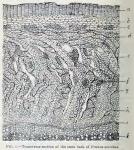
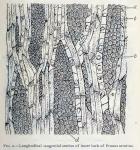

 Bark of the Stem of Prunus serotina.—The periderm or corky layer separates readily in transverse bands from the rather thin layer or cortex beneath. The latter contains numerous clusters of short sclerenchymatous cells or stone cells, which form an interrupted zone in this layer of bark. Just underneath this layer the medullary rays, whose course from the cambium zone outward is more or less wavy, terminate very obliquely. The rays in their thickest part are from four to six cells broad, and between them lie the bast masses which, except near the cambium zone, consist of crumpled sieve elements, sprinkled with masses of sclerenchyma. These masses are made up chiefly of stone cells, but sometimes contain more elongated elements, which, perhaps, might be regarded as bast fibres. They are, however, much shorter than bast fibres usually are, and every gradation between them and stone cells may be observed. The fissuring along the bast masses is conspicuous in the cross-section. In the older bark, crystals of calcium oxalate are so abundant as to seriously interfere with sectioning. These crystals are sometimes stellately clustered, but more commonly are single and are most abundant in the cells adjacent to the medullary rays.
Bark of the Stem of Prunus serotina.—The periderm or corky layer separates readily in transverse bands from the rather thin layer or cortex beneath. The latter contains numerous clusters of short sclerenchymatous cells or stone cells, which form an interrupted zone in this layer of bark. Just underneath this layer the medullary rays, whose course from the cambium zone outward is more or less wavy, terminate very obliquely. The rays in their thickest part are from four to six cells broad, and between them lie the bast masses which, except near the cambium zone, consist of crumpled sieve elements, sprinkled with masses of sclerenchyma. These masses are made up chiefly of stone cells, but sometimes contain more elongated elements, which, perhaps, might be regarded as bast fibres. They are, however, much shorter than bast fibres usually are, and every gradation between them and stone cells may be observed. The fissuring along the bast masses is conspicuous in the cross-section. In the older bark, crystals of calcium oxalate are so abundant as to seriously interfere with sectioning. These crystals are sometimes stellately clustered, but more commonly are single and are most abundant in the cells adjacent to the medullary rays.
The medullary rays contain usually an abundance of very fine-grained starch. The granules of starch are usually spheroidal and simple, with an inconspicuous central or sub-central hilum, and no other recognizable markings. Some double and treble grains, however, are observable.
The root bark of this species bears a close resemblance to that of the stem, but it is lighter exteriorly and the corky layer earlier begins to fissure. The clusters of sclerenchyma cells are less numerous, and the bast fibres somewhat better differentiated. They are still few in number, however, as compared with the stone cells, and they occur chiefly in association with the latter, though sometimes they are isolated or in separate clusters of few fibres.
Both root and stem bark are decidedly bitter and aromatic, and somewhat astringent to the taste. The aromatic or bitter almond odor and taste in fresh specimens are more pronounced in the root bark. This would lead to the inference that the latter is the more valuable of the two for medicinal purposes.
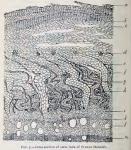
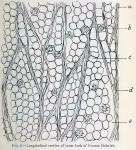
 The Stem Bark of Prunus Mahaleb.—The bark on the old stem is dark gray and fissured, though less strongly so than that on the trunk of Prunus serotina. There appears to be a greater development of secondary cortex in this species than in Prunus serotina, and a corresponding difference in the cork formation. Some of the later-formed bands of secondary cork not merely invade the inner cortex, but in the older bark cut even into the outer portion of the bast layer.
The Stem Bark of Prunus Mahaleb.—The bark on the old stem is dark gray and fissured, though less strongly so than that on the trunk of Prunus serotina. There appears to be a greater development of secondary cortex in this species than in Prunus serotina, and a corresponding difference in the cork formation. Some of the later-formed bands of secondary cork not merely invade the inner cortex, but in the older bark cut even into the outer portion of the bast layer.
The sclerenchymatous elements are less abundant than in Prunus serotina, and consist mostly of small clusters of bast fibres, stone-cells being wholly or nearly absent. The medullary rays are quite similar to those of P. serotina, and the intervening sieve elements are, in the older bast areas, likewise much crushed and fissured.
Crystals of calcium oxalate are abundant, but much less so than in P. serotina, and are seldom single in the cells, but in stellate clusters. Probably owing to the season of the year when the bark was gathered, namely, in June, no starch grains were recognized.
The bark has the bitterness and astringency of the official species, but much less of the aromatic quality.
Often the portions of the wood adhering to a medicinal bark afford characters which aid in identification. Between the wood of Prunus Mahaleb and that of the official species there are marked structural differences. The ducts of the former are much larger and also less evenly distributed, being most abundant and largest adjacent to and on the exterior side of the ring of growth, so that the rings of growth are rendered much more conspicuous to the eye.
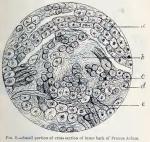

 The Stem Bark of Prunus Avium.—The bark of this species is smoother and lighter colored, being reddish-brown on the twigs of the second or third year, and deep gray or reddish-gray on the trunk. The lenticels on the twigs are much fewer than in the official species, but they are still present and enormously increased in size in trunks 6 inches or more in diameter. They appear as lenticular, transversely elongated, corky patches, often 2 inches or more in length. The outer bark may be easily stripped off transversely in broad bands, exposing the deep green middle bark, and the corky layer, in turn, may be easily split into thin lamellae, corresponding to the concentric stratification lines seen in the cross-section.
The Stem Bark of Prunus Avium.—The bark of this species is smoother and lighter colored, being reddish-brown on the twigs of the second or third year, and deep gray or reddish-gray on the trunk. The lenticels on the twigs are much fewer than in the official species, but they are still present and enormously increased in size in trunks 6 inches or more in diameter. They appear as lenticular, transversely elongated, corky patches, often 2 inches or more in length. The outer bark may be easily stripped off transversely in broad bands, exposing the deep green middle bark, and the corky layer, in turn, may be easily split into thin lamellae, corresponding to the concentric stratification lines seen in the cross-section.
The inner bark shows the wavy medullary rays, terminating very obliquely at the exterior, the wavy bands of compressed sieve tissue in the older portions, and the fissuring between the medullary rays and the bast masses, which are shown in most species of cherry; but it differs from the official species and from some others in the decidedly fibrous character of the bast layer. There are not only scattered and very tortuous lignified fibres in its outer portions, or even extending into the middle bark, but clusters and isolated fibres occur abundantly throughout the bast. Many of the fibres, especially those occurring in bundles, are long and slender, and run quite regularly lengthwise of the bark; but others, especially the isolated ones, are very irregular in form, tortuous in their course, and often branching.
The masses of bast fibres are never very large, and are not arranged with any apparent order.
Crystals of calcium oxalate in the specimens examined were much less abundant than in P. serotina, and they were nearly always in stellate masses.
The specimens studied were gathered in June and July, and in these, starch, though present in the medullary ray-cells, was not abundant. It was also very fine grained; the grains were often rounded and simple, but also frequently double or triple. The faintly distinguishable hilum is nearly central. The taste of this bark is decidedly bitter and astringent, but the aromatic or bitter almond odor and taste are usually scarcely perceptible.


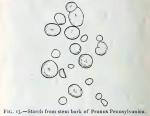 The Stem Bark of Prunus Pennsylvanica.—This tree, when not in fruit or flower, might be mistaken for a small specimen of P. serotina, for the habit is similar, and the bark of the trunk, though usually lighter colored and smoother than that of the official species, is occasionally, in the old specimens, quite dark and rough enough to resemble that of young and thrifty specimens of P. serotina of similar size. The lenticels on the twigs, however, perceptible also even on the older trunks, are much less numerous. Of course, there would be no difficulty in distinguishing this species when in flower, for its flowers occur in umbel-like clusters instead of racemes; in early instead of late spring; and from separate, lateral scaly buds instead of on the ends of lateral leafy branches. The fruits also are red, on long pedicels, and with a thinner, more acid and not a bitter taste.
The Stem Bark of Prunus Pennsylvanica.—This tree, when not in fruit or flower, might be mistaken for a small specimen of P. serotina, for the habit is similar, and the bark of the trunk, though usually lighter colored and smoother than that of the official species, is occasionally, in the old specimens, quite dark and rough enough to resemble that of young and thrifty specimens of P. serotina of similar size. The lenticels on the twigs, however, perceptible also even on the older trunks, are much less numerous. Of course, there would be no difficulty in distinguishing this species when in flower, for its flowers occur in umbel-like clusters instead of racemes; in early instead of late spring; and from separate, lateral scaly buds instead of on the ends of lateral leafy branches. The fruits also are red, on long pedicels, and with a thinner, more acid and not a bitter taste.
The lenticels on the trunk are not so large as those of P. Avium, seldom attaining a length transversely of more than half an inch. The corky layer, however, separates from the sub-lying green tissue in a very similar manner, and in cross-section this layer shows a similar, though finer, stratification. When the brown or blackish scurf is rubbed from the surface of the periderm, a fine red-brown or mahogany color is exposed.
In this species, as in P. Avium, there appears to be but a slight development of the secondary cortex. Similarly, the medullary rays of the inner bark are oblique and wavy. They are, however, narrower, being seldom more than three cells broad. The fissuring and the collapsed sieve tissue are also similar. The older portions of the inner bark abound in tortuous and strongly lignified sclerenchyma fibres, similar to those of P. Avium, but the clusters of more typical bast fibres are considerably less numerous.
The taste of this bark resembles that of P. Avium, being decidedly bitter, somewhat astringent, but scarcely at all aromatic.
Crystals of calcium oxalate abound, and they are mostly in stellate masses.
The starch grains are similar in shape to those of P. Avium, but they average of larger size, and compound forms appear to be somewhat less numerous.
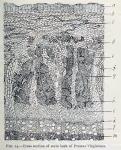 Stem Bark of Prunus Virginiana.—This tree, commonly called Choke Cherry, on account of its very astringent fruit, is undoubtedly often confounded with the Black Cherry. This is not only because it is often, in general appearance, similar to that of a small black cherry tree, but because its flowers and fruits are similar in size, color and arrangement, being borne in both cases in racemes. Our pharmaceutical nomenclature also adds to the danger of confusion, the name Prunus Virginiana being still absurdly retained as the pharmacal name of the drug obtained from P. serotina.
Stem Bark of Prunus Virginiana.—This tree, commonly called Choke Cherry, on account of its very astringent fruit, is undoubtedly often confounded with the Black Cherry. This is not only because it is often, in general appearance, similar to that of a small black cherry tree, but because its flowers and fruits are similar in size, color and arrangement, being borne in both cases in racemes. Our pharmaceutical nomenclature also adds to the danger of confusion, the name Prunus Virginiana being still absurdly retained as the pharmacal name of the drug obtained from P. serotina.
There is no real reason, however, why any one tolerably familiar with the botanical characters of the two species should confound them, for there are marked differences. P. Virginiana is, in the first place, a much smaller tree, in fact, usually more a shrub than a tree, though sometimes its stem attains a diameter of two or three inches. Its branches and trunk are not so dark, being rather grayish than blackish, and the lenticels are much less numerous. Its leaves are thin, oval-oblong or ovate, abruptly pointed, and sharply serrate, with slender, projecting teeth, while those of the black cherry are thickish, oblong-lanceolate or oblong and taper-pointed, but less abruptly so than in the other species, and the margins are serrate with incurved, short and callous teeth. The serrations on the leaves of Choke Cherry are also often double, which is not the fact with those of the Black Cherry. The petals of the Choke Cherry are more rounded than those of the Black Cherry.
The microscope, however, reveals the most decided differences in the structure of the barks. The medullary rays in P. Virginiana, which are three or four cells wide, are less flexuous than in P. serotina, or in any other species examined. Proper stone cells, so abundant in the bark of the Black Cherry, are almost wholly absent from the bark of the Choke Cherry, but the tortuous sclerenchyma fibres, similar to those in P. Avium and P. Pennsylvanica, not only abound in the inner bark, but in the cortex. Bast fibres of the ordinary form also occur in large and irregular masses in all the mature portions of the inner bark. By reason, perhaps, of the abundance of bast fibres, the radial fissuring, so observable in all the other species studied, is much less conspicuous in this.
Owing, probably, to the fact that the specimens studied were gathered in the season of active growth, namely, about June 1st, no starch was found in the sections examined.
Oxalate of calcium crystals in stellate masses are abundant in the species.
In aromatic quality and in bitterness, this species is inferior to the Black Cherry, though the bitter almond odor and taste are much more evident than in any of the other species thus far studied.
Another cherry bark, samples of which were sent by Professor Henry G. Greenish, of London, has been examined by the writer, and found to resemble, in most of its structural characteristics, that of our P. Pennsylvanica. It differs from the bark of this species, markedly, however, in some particulars, and was probably derived from one of the unstudied Pacific Coast species. The sample was very bitter, somewhat astringent, and slightly aromatic. Professor Greenish states that the sample was taken from a quantity which had been sent to the London market as Wild Cherry Bark.
This outline of the studies thus far made by the writer in this genus must be considered merely as preliminary to a more complete account which he expects to publish at a future time. In the meantime, it is hoped that the descriptions and illustrations here given may be of service to our profession, and aid in emphasizing the importance of the study of the histological structure of drugs.
The writer's thanks are due to Mr. Henry L. Clarke, of the University of Chicago, for securing for him authentic specimens of the bark of Prunus Virginiana.
The American Journal of Pharmacy, Vol. 67, 1895, was edited by Henry Trimble.

